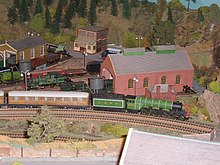OO gauge
| 00 | |
|---|---|
 U.K. prototype model of a 00 scale (1:76) British Rail Class 25 shown with an 18mm-five pence coin for scale. | |
| Scale | 4mm to 1ft |
| Scale ratio | 1:76.2 |
| Model gauge | 16.5mm |
| Prototype gauge | Standard gauge |
00 gauge or 00 scale model railways are the most popular standard-gauge model railroad tracks in the U.K. This track gauge is one of several 4mm-scale standards (4mm:foot (304.8mm) or 1:76.2) used — the only one served by manufacturers; 00 gauge track is 16.5mm gauge, which is inaccurate for 4mm scale. The name is also often written OO scale with the letter instead of the number, not recognising that the name is a progression from the earlier 0 gauge, 1 gauge, 2 gauge and 3 gauge.
Origin
Double-0 scale model railways were launched by Bing in 1921 as 'The Table Railway', running on 16.5 mm track and scaled at 4 mm to the foot. In 1922, the first models of British prototypes appeared. Initially all locomotives were powered by clockwork, but the first electric power appeared in autumn 1923.

00 scale uses the same track gauge as H0 gauge (3.5 mm to the foot, 1:87). However, the large propulsion mechanisms could not fit into the small British prototypes, so the scale was enlarged to 4 mm to the foot without altering the gauge.
In 1932 the Bing company collapsed, but the Table Railway continued to be manufactured by the new Trix company. Trix decided to use the new H0 standard, being approximately half of European 0 gauge (1:43 scale).
In 1938, the Meccano Company launched a new range of 00 models under the trade name of Hornby Dublo, and 00 gauge has remained the UK's most popular ever since.
In the United States, Lionel Corporation introduced a range of 00 models in 1938 as well. Soon other companies followed but it did not prove popular and remained on the market only until 1942. 00 gauge was quickly eclipsed by H0 scale.
Scaling
16.5mm gauge at 4mm:1 foot means that the scale gauge represents 4ft 1½in, seven inches narrower than the prototype 4 ft 8+1⁄2 in (1,435 mm). These noticeable differences are aggravated by the over-scale rail section, over-scale wheel width and deep wheel flanges used on many models. These departures from scale require much larger clearances on pointwork and are particularly noticeable when looking along the track. This scale gauge more accurately represents the narrow gauge railways built to 48 gauge, for example the Padarn Railway and Saundersfoot Railway in Wales and the Glasgow Subway in Scotland.
Though they run on the same track, 00 gauge and H0 gauge models do not sit well together since the British models are larger than their European or American counterparts, when the reverse ought to be the case.
00 is also used to represent the 63 Irish gauge, where it is a scale 13½ inches too narrow.
These differences have led to the development of the finescale standards EM gauge and P4 scale.
00 today
To this day 00 remains the most popular scale for railway modelling in the United Kingdom; this is most likely attributable to a ready availability of ready-to-run stock and starter sets. This particular area in itself is dominated by Hornby Railways, and Bachmann Branchline. Other sources of ready-to-run rolling stock or locomotives include the Dapol, Heljan, Peco, ViTrains. Other scales, with the possible exception of N gauge, lack the variety of ready-to-run products, and it is likely this that deters British modellers and leads to the prevailance of 00.
Good results in 00 can be achieved despite the scale inaccuracies if one uses more modern ready-to-run equipment on ballasted Code 75 trackwork (e.g. Peco Streamline), with realistic track spacing (the "6 foot"), and try to minimise or hide curves where necessary. Most finescale modellers began in 00, developed their skills and advanced to finescale.
4 mm Finescale Standards
Many experienced modellers find the 00 standard produces a "narrow gauge" appearance when the model is viewed from head on. Greater accuracy is possible using either EM gauge or the closer to exact scale P4 gauge track.
Whilst flextrack is available for both EM and P4 gauges (from manufacturers such as C&L Finescale, SMP and The P4 Track Company), ready-to-run (RTR) point and crossing (P&C) work is not available, so P&C trackwork must be constructed by the modeller. Kits for doing this are also available from the aforementioned sources amongst others. Several of these kits are also available for the 00 modeller who aims for more realistic track, since most RTR track does not represent any British prototype and the sleeper spacing is too close together for scale. EM gauge has slightly overscale flanges and flangeways on point and crossing work; P4 is closer to scale but the smaller flanges and flangeways on P&C work expose poor track construction.
See also
Related scales
- OO9 - Used for modelling 2 ft narrow gauge railways in 4mm scale
- OOn3 - Used for modelling 3 ft narrow gauge railways in 4mm scale
- H0 - 3.5mm scale using the same 16.5mm gauge track as 00.
- EM - 4mm scale using 18.2mm gauge track.
- P4 - A set of standards using 18.83 mm gauge track (accurate scale standard gauge track).
Manufactures
- Bachmann Branchline - One of the largest manufactures of ready to run 00
- Dapol - Produce kits and ready to run wagons
- Heljan - Produce a small number of locomotives and wagons
- Hornby Railways - One of the largest manufacturers of ready to run 00
- Lima - Produced budget 00 ready to run, bought by Hornby
- Peco - Produce a wide range of track
External links
- Willets Scale Models, Specialist manufacturer in 4mm scale railway stock.
- Double O gauge Association
- History of 00 gauge
